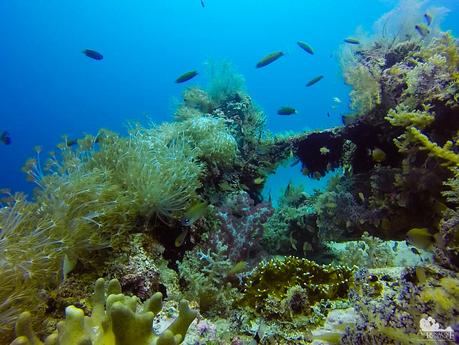
In general, natural places where modernity and humanity have encroached experience some sort of change. Most exhibit a degree of damage while some are even downright devastated. So it’s a really a joyful feeling when we encounter beautifully preserved natural areas right in the heart of a bustling province. The Talima Marine Sanctuary in right at the fringe of a busy shipping lane in Mactan, Philippines is a clear proof that man and nature can harmoniously coexist.
While on our way to our dive site, Boo briefed the newcomers who are going to have their DSD. This DSD session will open their eyes to the wonders of the alien world under the waves. But more importantly, we hope that they will realize just how important, beautiful, massive, and fragile our marine ecosystem is. With that knowledge, they will hopefully become stewards of the environment.
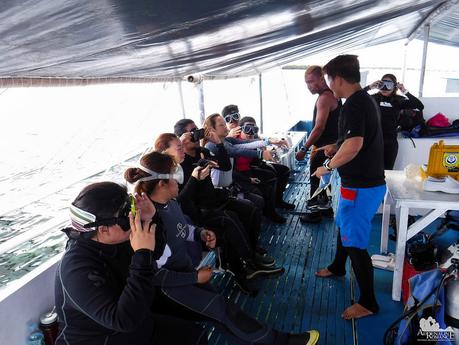
Soon, we crossed the Hilutungan Channel and arrived at the Talima Marine Sanctuary right in front of Olango Island. The sanctuary is on top of an underwater plateau with a gentle downward slope. The edge of the plateau is a steep drop-off that goes to a depth of around 165 feet.
With gorgeous corals and huge schools of fish, the Talima Marine Sanctuary is a favorite spot for scuba divers, free divers, and snorkelers of all experience levels. Watchful and diligent Bantay Dagat personnel monitor the sanctuary to ensure it is healthy and protected.
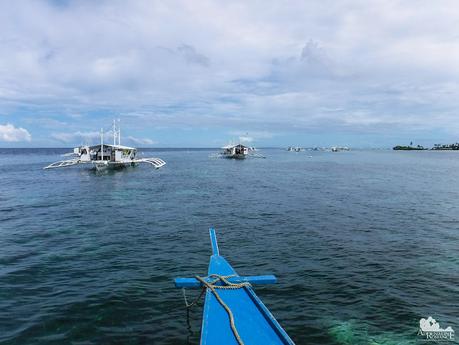
The DSDers suited up and jumped into the water. Once Boo and his fellow divemasters gave the signal to descend, they had their chance to breathe underwater. Breathing underwater for the first time is always a memorable experience. At your first comfortable breath, you realize that a new world has been opened for you.
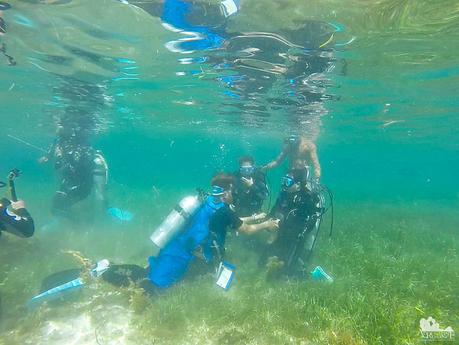
Sheila and I geared up and went with Boo to explore the sanctuary. As always, we were astounded at the beauty of a healthy, living reef with all the biodiversity that surrounds us. We saw a giant barrel sponge that served as a home to three cleaner bluestreak wrasses. This one is around three feet tall, but it’s a “child” compared to the huge ones we encountered in Anilao, Batangas.
Like all other sponges, the barrel sponge is a filter feeder. Water continuously goes through the sides of the sponge, and structures in the sponge’s body filter out microscopic plankton which they eat for food.
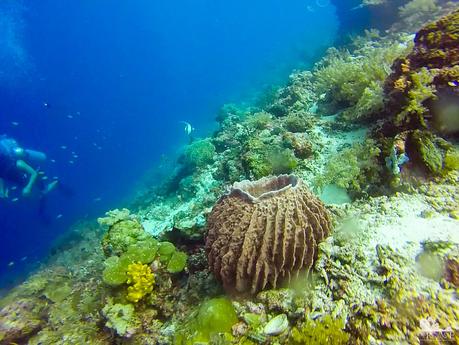
A blue nudibranch slithers along a group of soft corals. Nudibranches display an infinite myriad of colors to warn potential predators that they are not good to eat. This property is called aposematism.
They are all carnivorous, and occasionally, they feed on members of their own species. These shell-less molluscs are also hermaphrodites, meaning, they have both male and female reproductive organs. Nature is simply amazing!
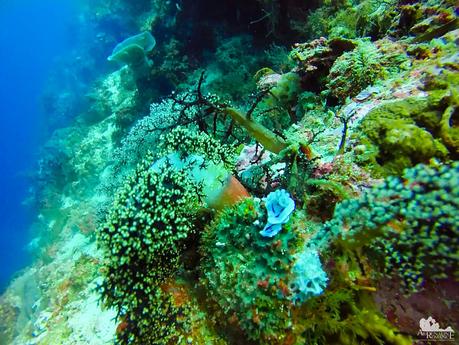
The Talima Marine Sanctuary is well known for its rich assortment of gorgonians, or sea fans due to their fan-like shape. Gorgonians are soft, delicate coral. The branches can range between a few inches inches to several feet high. Due to their beautiful shapes and colors, gorgonians are favorite subjects of underwater photography.
Researchers recently discovered that gorgonians produce unique compounds called diterpenes that can be used to produce new medicines.
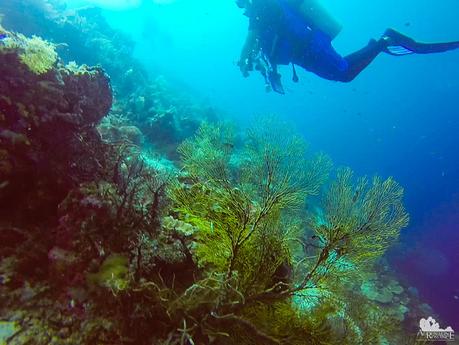
Each branch of sea fan is made up of thousands of individual polyps. You can think of a polyp as a tiny invertebrate with a mouth surrounded by tentacles. It catches plankton for food.
These branches are very delicate, so we’re very careful not to touch them. A slight brush can break off those branches, and considering that these are made of life-giving polyps, a snap can impair the feeding cycle of the coral.
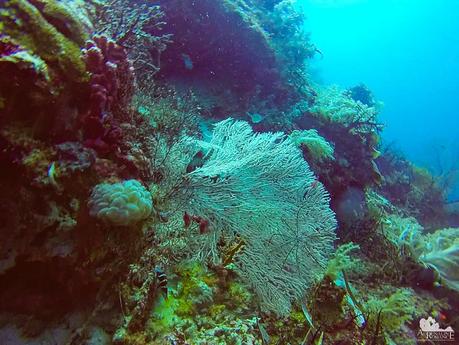
Is this a gorgonian? Well, no, but it looks similar. That is a hydroid. Hydroids are predators that are related to jellyfish.
The one in the photo is a stinging hydroid. Poisonous barbs on those needle-like branches are used both for offense and defense. The venom is fatal for small marine organisms, but rarely dangerous to humans unless the individual is allergic to such venom.
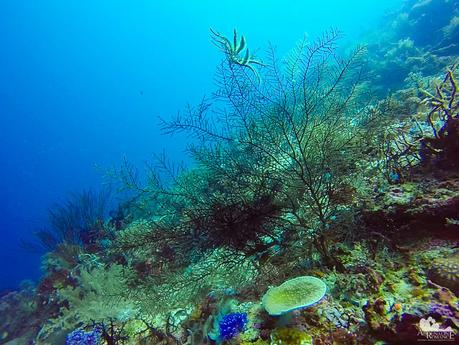
Lots of yellow nephtheidae and black nidaliidae corals spread on the sea floor like an underwater forest. Unlike real forests however, these corals are not plants but animals!
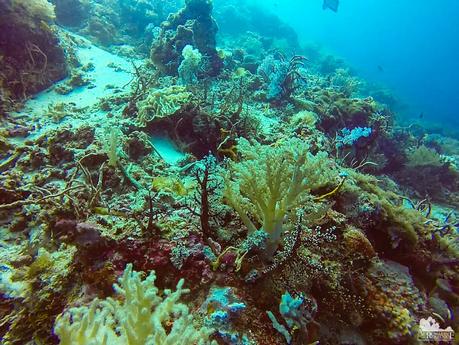
The vibrant colours of the Nephtheidae coral make them popular for hobbyists who love to take care of saltwater reef aquariums.
Like hard corals, soft corals produce calcium carbonate. Unlike hard corals, however, the calcium carbonate is spread over the coral as tiny splinters called spicules. The spicules give the coral the ability to flex and bend with the current.
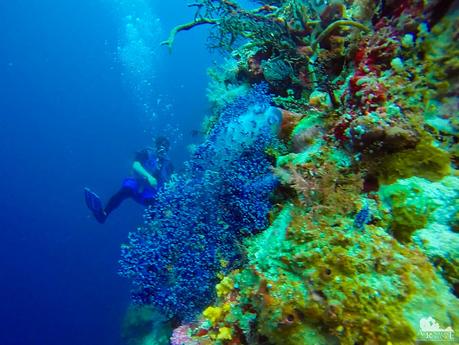
Dark-colored sea whips compete with nephtheidae corals for space. Sea whips are similar to gorgonians, their long “whips” filled with polyps. Like all soft corals, they dance with the current.
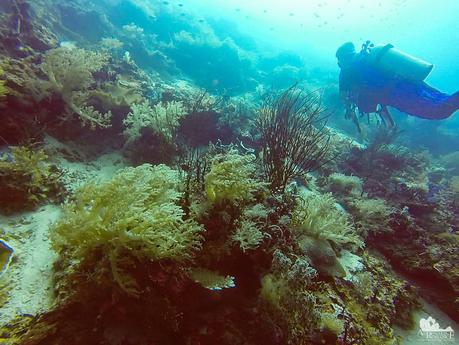
Hard corals are foundation species; they are the builders of the reef. They are the buildings, bridges, houses, parks, streets, highways, and other structures to a city. Without these structures, you can’t have a city.
Coral polyps have a symbiotic relationship with tiny microscopic algae called zooxanthellae that are leaving among htem. These algae are photosynthetic, meaning, they get their food from the sun. They share this energy together with the coral polyp. Yes, corals are solar powered!
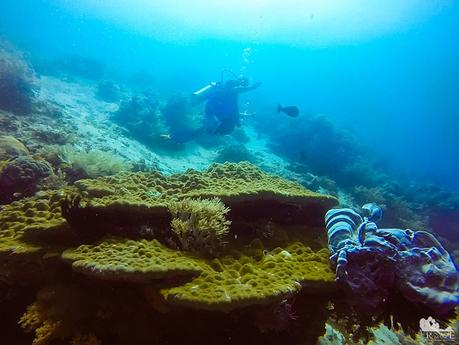
Corals provide shelter and protection for all kinds of marine life. These small humbug damselfish rushed to the protection of a coral as we approached their home. They don’t venture out very far from their coral home.
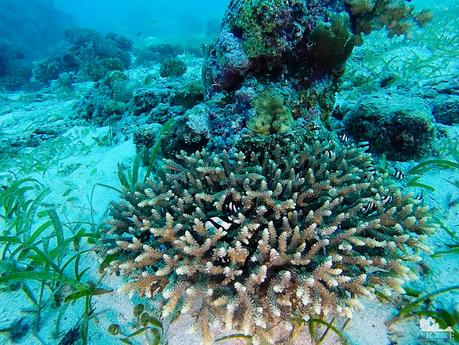
As we head to shallow water for a safety stop, Boo lead us to a large area filled with swaying Nephtheidae corals. This is actually a successful soft coral farm and restoration project. As you can see, all corals are healthy and stunning.
It’s hard to believe that all these started out as small buds that are tied on a few metal frames. Today, you can’t even see the frames where they were originally attached to.
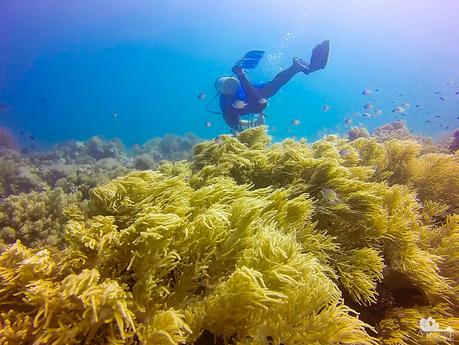
With our tanks running low on air, we surfaced and joined the rest of the DSDers back on the boat for a one-hour surface interval. Over lunch, we discussed about the newbies’ first underwater experience. They were definitely ecstatic, and some even asked Boo for rates about their certification.
After lunch, we transferred to another part of the sanctuary and geared up. Almost immediately after we entered the water, we were assaulted by hundreds of reef fish! This presence of these huge schools is another highlight of the Talima Marine Sanctuary.
Locals said that decades ago, large marine animals such as turtles, sharks, and rays made the stretch of the Hilutungan Channel as their home. But as the channel got busy and noisy due to passing vessels, they were driven out of their habitat.
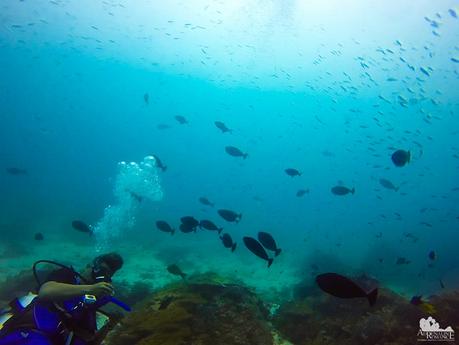
And mind you, these are not small, inch-long fish. Many of the fish in this area are over a foot long! And just imagine being surrounded by hundreds upon hundreds of them!
These are curious black Indian triggerfish coming over to check us out. They are quite used to divers, so they don’t bite.
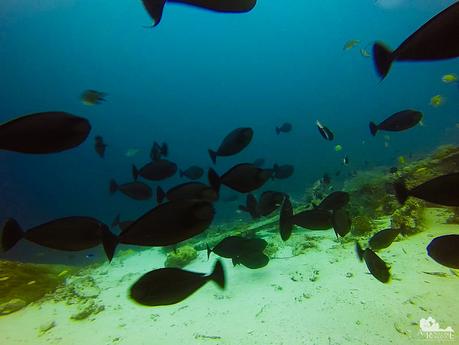
Near a coral head, a trio of striped sweetlips along with small yellow anthias wait for their turn to be cleaned by small bluestreak wrasses. The wrasses pluck off dead skin and parasites from the bigger fish. This is a symbiotic relationship; the sweetlips enjoy a relaxing spa while the wrasses get a meal.
Juvenile sweetlips start out their lives very differently. The young ones look like small spotted orange fish that swim using an undulated pattern similar to the movements of a poisonous sea slug. This mimicry is their defense mechanism.
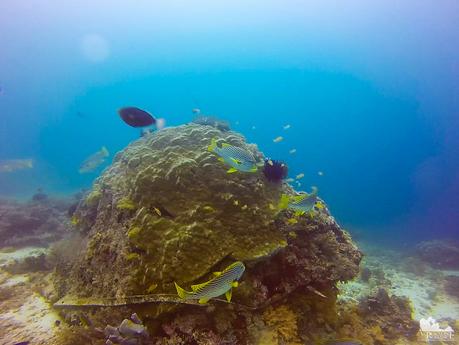
An orange clownfish peeked at us as we went near its anemone home. Clownfish are territorial, and they rarely leave their anemones. This one was curious and swam towards us but making sure that its protective anemone is within quick reach.

Nearby, a lionfish hid in a crevice. Its fins have spines that pack a powerful venom that is used to protect the fish. But long as you don’t touch it, a lionfish don’t pose a threat and would even stay still for a photo!
Nighttime, however, is a different story. The lionfish becomes a stalking predator which has a voracious appetite. No small fish is safe from it.
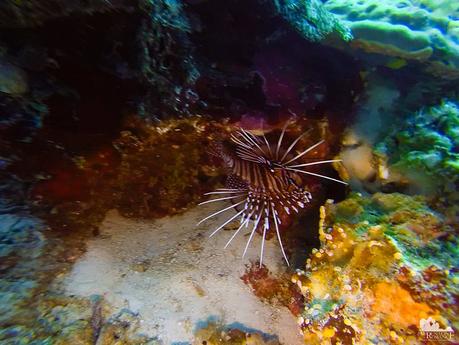
A large butterfly fish about a foot long came to check out us but kept a respectable distance. With its silver body and yellow fins, it looks really regal.
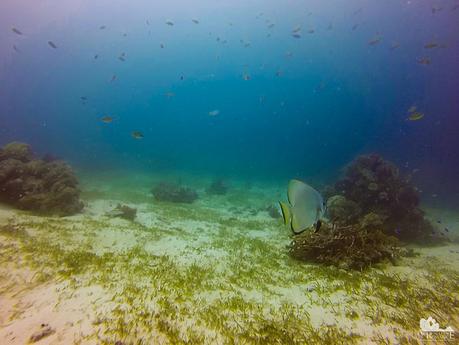
Another highlight of the Talima Marine Sanctuary is the skeleton of the keel of a small wooden ship. Divers call this The Shipwreck, but they just seem like wooden boards piled here and there.
Over the years, all kinds of corals, sponges, and hydroids have grown all over the keel. The wreck has become an artificial reef that is a cool home for various marine animals.
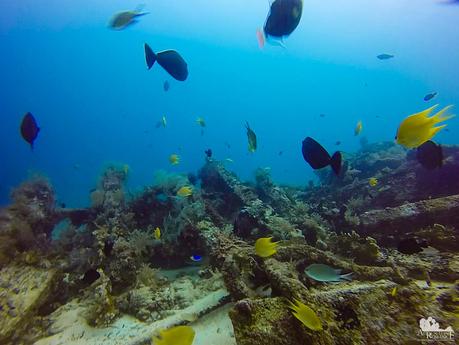
Let’s go closer. A sweetlips and a large blue damselfish scour the shipwreck for potential food. Fish love to hang out here. With nooks, crannies, and tunnels, it’s like an underwater playground for them.
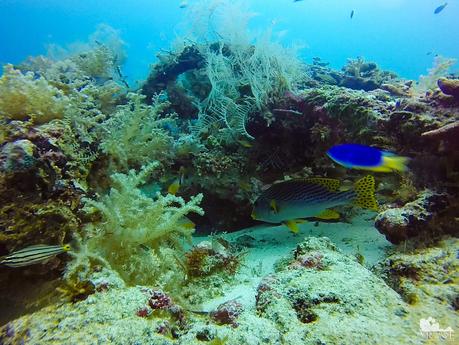
Look at all that rich marine life in just one small section of the wrecked keel! The wreck provided the fish a home on a supposedly sandy and featureless bottom.
Intentionally sinking damaged or decommissioned ships (after removing everything that can pose a danger to marine life and human divers) on featureless bottoms is a great example of how man and nature can work together in harmony. Sheila and I are planning to train to more advanced diving courses so will be officially licensed to explore wrecks.
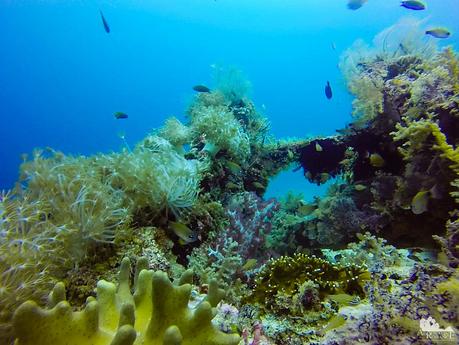
This was perhaps one of our most interesting finds. That’s a coral with glowing blue polyps on a dark exoskeleton. The polyps look large because they have extended out of their skeletons; usually, this happens at night. So why is this happening during the day? We don’t know.

As we headed back to shallow water, we encountered a large anemone with a fully exposed mesentery. The purpose of the mesentery is not really clear, but marine biologists believe that they are used for support the shape of the anemone.
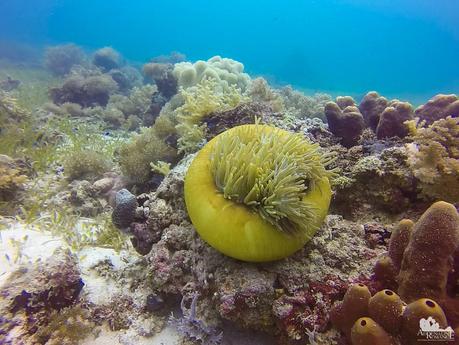
A group of pipe sponges expel water from their osculum, or mouth. Sponges are great habitats for fish and are food for sea turtles.
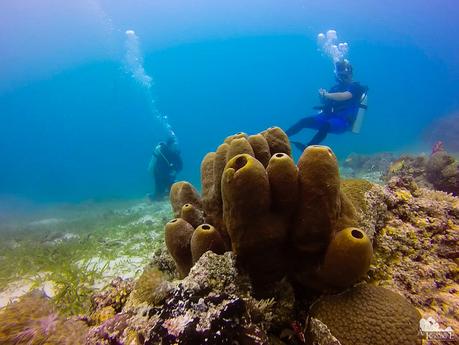
The weekend dive was definitely enjoyable. The newbies had their first awesome experience in breathing, floating, and moving underwater like a fis while Sheila and I had an amazing tour of one of Cebu’s most beautiful and well-preserved marine treasures.
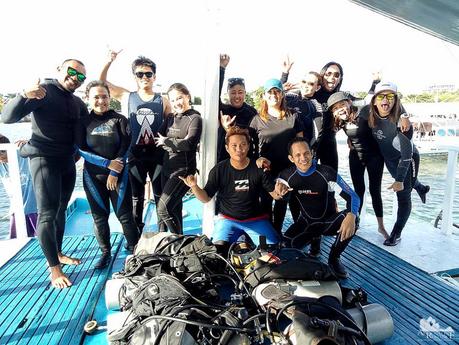
The Talima Marine Sanctuary is an example of mutual symbiosis between humanity and nature. With diligent guardianship, sufficient funding, discipline in part of the visitors, and strict implementation of environmental laws, we are sure that the sanctuary will flourish for years to come.
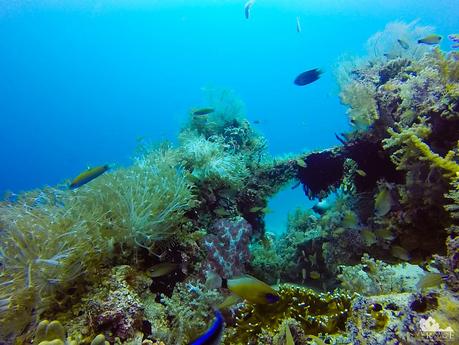
Information and Rates About the Talima Marine Sanctuary
- Address: Olango Island, Mactan, Cebu, Philippines
- Operating Schedule: Daily unless advised by the Bantay Dagat or Coast Guard
- Reef Fee: P100 per person
- Notes: The marine sanctuary is perfect for beginner and advanced divers alike. A gentle current runs southward across the entire plateau.
Contact Details
For your scuba diving adventures, get in touch with Scuba Star Dive Services using the following contact details.
- Mailing Address: Scuba Star Dive Services, Buyong Beach, Maribago, Lapu-Lapu City, Cebu, Philippines 6015
- Email Address: [email protected]
- Landline: (6332) 494-1338
- Mobile Phone: 0916-257-2856 / 0932-445-5967
- Facebook Page: Scuba Star Dive Services
- Contact Persons: Rambo, Analyn, or Linda.
Scuba Star Dive Services also offers various certification courses.
Tips
1. There are more than two dozen dive sites around Mactan and Olango islands. You can’t finish them all in one day! But don’t worry because this area has a lot of hotels, resorts, and other types of accommodation where you can stay.
2. For optimum visibility, it is best to dive in the morning when the sun is shining and at the right angle. In addition, there are usually fewer divers in the morning, so heavy siltation is not likely to obscure visibility.
3. Several dive sites in Mactan and the Olango Chain have different conditions and characters. That means, some dive sites require a higher level of scuba diving experience and skill. Be sure to tell your Divemaster your skill level.
4. Establish neutral buoyancy as soon as you can to avoid touching the corals and seabed.
5. The dive shop will take care of your scuba equipment, so you don’t have to worry if you are not bringing your own set. Pack light but do bring the following:
- extra water ( at least 2 liters per person)
- swimwear such as rash guard and swimming shorts
- aqua shoes or slippers
- snacks or packed meals (make sure you bring enough for the divemasters and the boatmen)
- personal medication and toiletries
- waterproof camera
- mask and snorkel (for snorkelers)
6. Be a safe and responsible diver. Always observe the Leave No Trace principle. Never touch, disturb, tease, or collect marine wildlife. Remember we are in a protected area and an alien world that demands respect.

